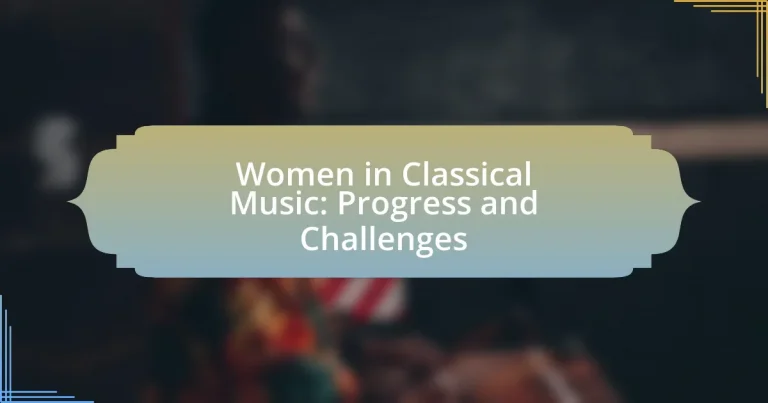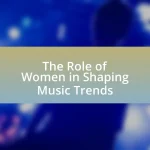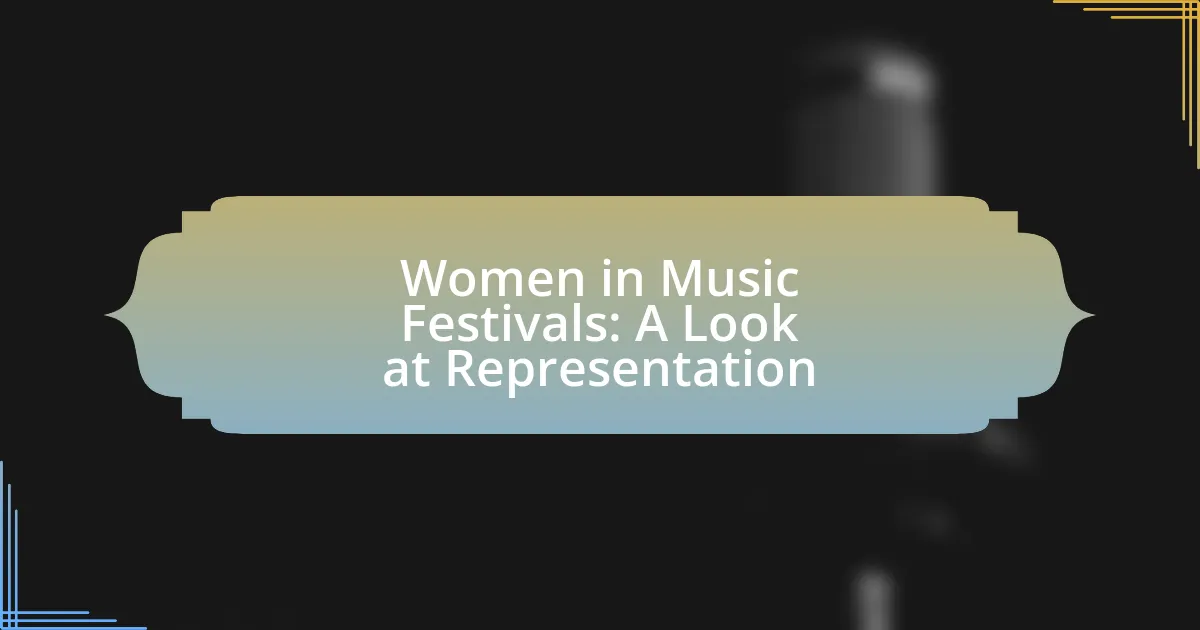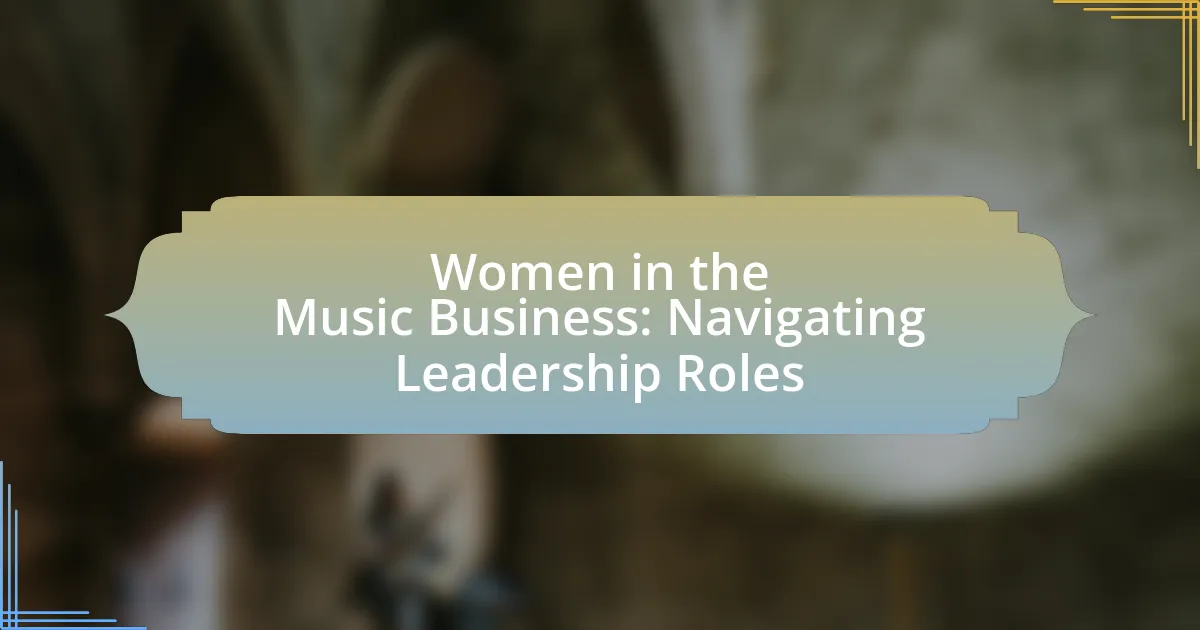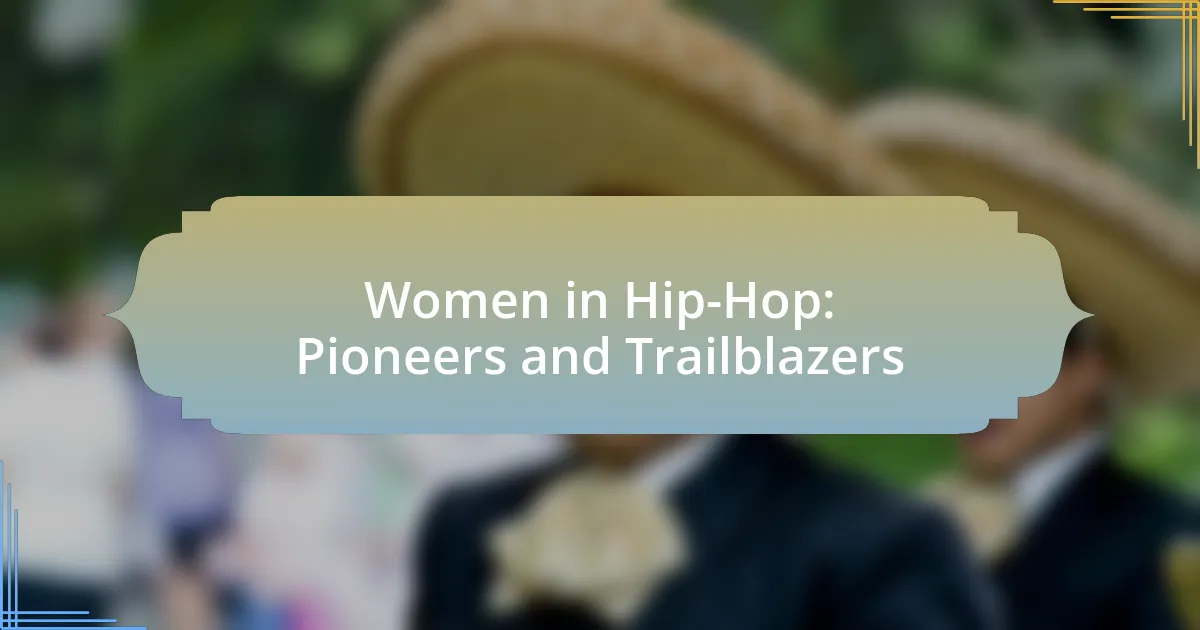The article examines the role of women in classical music, highlighting their contributions as performers, composers, conductors, and educators. It discusses the historical barriers women faced, the progress made towards gender equality, and the ongoing challenges such as underrepresentation and pay disparities. Key figures like Clara Schumann, Amy Beach, and Florence Price are noted for their significant impact on the genre, while recent movements and initiatives aimed at supporting female musicians are also explored. The article emphasizes the importance of continued advocacy for gender equity in the classical music industry.
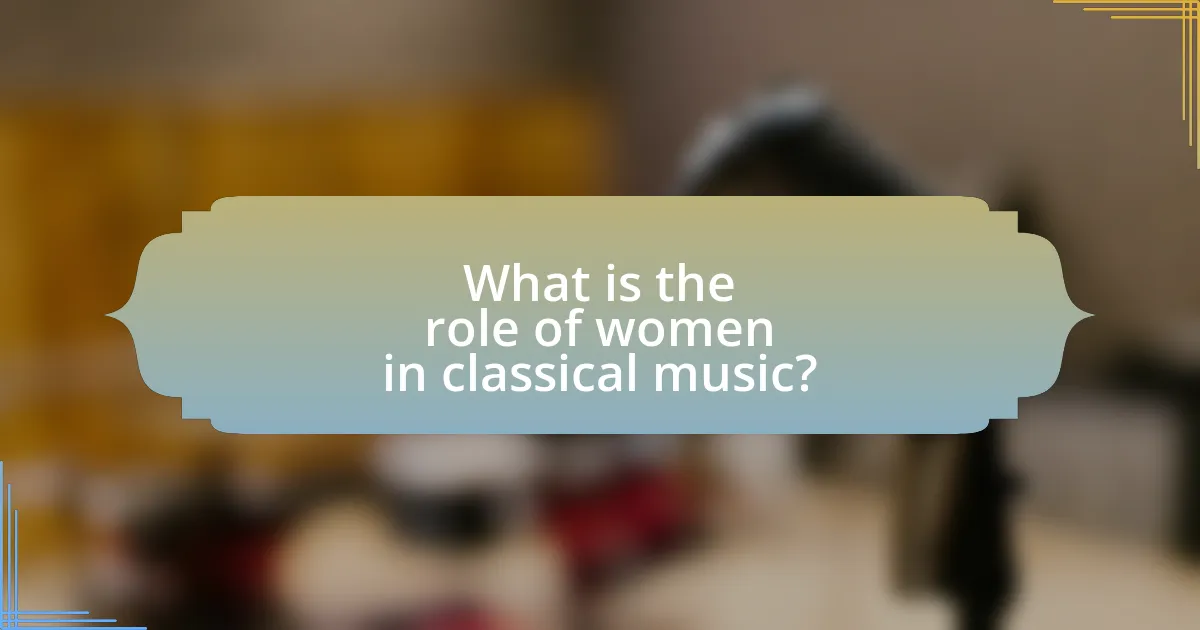
What is the role of women in classical music?
Women play a crucial role in classical music as performers, composers, conductors, and educators, significantly contributing to the evolution and diversity of the genre. Historically, women faced barriers to entry in classical music, often being excluded from formal training and performance opportunities. However, in recent decades, their presence has increased, with notable figures such as Clara Schumann and Ethel Smyth paving the way for future generations. According to a 2020 study by the League of American Orchestras, women now hold approximately 50% of positions in orchestras, reflecting a shift towards greater gender equality in the field. This progress highlights the ongoing challenges women face, including representation in leadership roles and recognition for their contributions, underscoring the importance of continued advocacy for gender equity in classical music.
How have women contributed to classical music throughout history?
Women have significantly contributed to classical music throughout history by composing, performing, and influencing the development of the genre. Notable figures include Clara Schumann, who was a pioneering composer and pianist in the 19th century, and Fanny Mendelssohn, whose works were often overshadowed by her brother Felix but are now recognized for their originality and depth. Additionally, women like Nadia Boulanger shaped music education and mentored many prominent composers in the 20th century. The presence of women in orchestras and as conductors has also increased, with figures like Marin Alsop breaking barriers in a traditionally male-dominated field. These contributions highlight the essential role women have played in enriching classical music’s history and evolution.
What notable female composers have shaped the classical music landscape?
Notable female composers who have shaped the classical music landscape include Clara Schumann, Amy Beach, and Florence Price. Clara Schumann, a prominent pianist and composer in the 19th century, significantly influenced the Romantic era with her compositions and performances, showcasing women’s capabilities in a male-dominated field. Amy Beach, the first successful American female composer, made her mark in the early 20th century with works like her “Gaelic Symphony,” which was the first symphony composed and published by a woman in the United States. Florence Price, the first African American woman to have a symphony performed by a major orchestra, contributed to the classical canon with her rich orchestral works and choral compositions, highlighting the intersection of race and gender in classical music. These composers not only created significant works but also paved the way for future generations of female musicians and composers.
How have women’s roles in orchestras evolved over time?
Women’s roles in orchestras have evolved significantly from being largely excluded to achieving prominent positions. Historically, women were often relegated to roles such as vocalists or playing in all-female ensembles, with orchestras being predominantly male. In the late 20th century, changes began to occur, particularly with the introduction of blind auditions in the 1970s, which aimed to reduce gender bias. This practice led to a notable increase in the hiring of female musicians; for instance, the percentage of women in major orchestras in the United States rose from about 5% in the 1970s to over 30% by the early 2000s. Today, women hold key positions, including conductors and concertmasters, reflecting a broader acceptance and recognition of their contributions to orchestral music.
What barriers have women faced in classical music?
Women in classical music have faced significant barriers, including gender discrimination, limited access to opportunities, and underrepresentation in leadership roles. Historically, women were often excluded from prestigious music conservatories and orchestras, which restricted their professional development. For instance, a study by the League of American Orchestras in 2019 revealed that only 30% of musicians in major orchestras were women, highlighting the ongoing gender disparity. Additionally, women composers and conductors have struggled for recognition, with many works overlooked in favor of their male counterparts. These barriers have contributed to a systemic lack of visibility and support for women in the classical music field.
How do societal norms impact women’s participation in classical music?
Societal norms significantly impact women’s participation in classical music by perpetuating gender stereotypes that discourage female musicians from pursuing careers in this field. Historically, classical music has been dominated by male composers and performers, leading to a perception that women are less capable or suited for serious musical careers. For instance, a study published in the Journal of Musicology found that women are often underrepresented in orchestras and music conservatories, with only about 30% of professional orchestral musicians being female. This underrepresentation is influenced by societal expectations that prioritize traditional gender roles, which can limit women’s opportunities for training, mentorship, and performance. Additionally, women frequently face biases in audition processes, where blind auditions have been shown to increase their chances of selection, highlighting the impact of societal perceptions on their participation.
What challenges do female musicians encounter in the industry today?
Female musicians encounter significant challenges in the industry today, including gender bias, lack of representation, and limited access to opportunities. Gender bias manifests in various forms, such as unequal pay and fewer promotional opportunities compared to their male counterparts. According to a study by the Berklee College of Music, female musicians earn approximately 30% less than male musicians for similar roles. Additionally, women are underrepresented in leadership positions within music organizations, which affects decision-making processes and opportunities for female artists. A report from the Annenberg Inclusion Initiative highlights that only 22% of artists on popular music charts are women, indicating a systemic issue in representation. These challenges hinder the progress and visibility of female musicians in the industry.
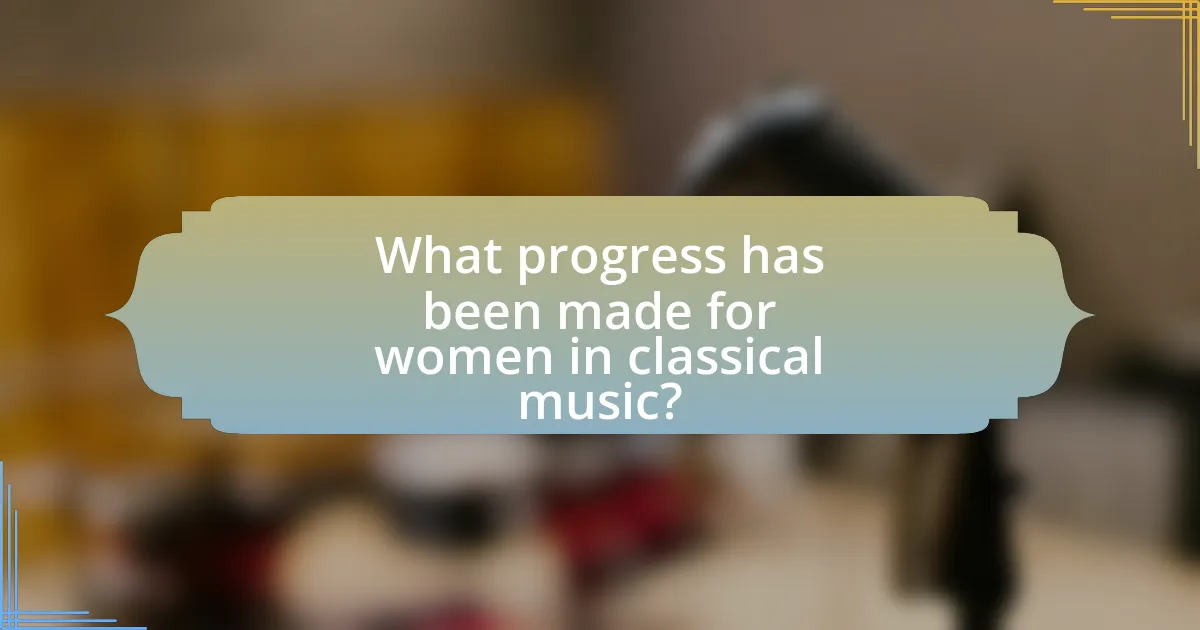
What progress has been made for women in classical music?
Progress for women in classical music includes increased representation in orchestras, higher visibility in solo performances, and more women in leadership roles within music organizations. For instance, as of 2021, women held 50% of the positions in major orchestras in the United States, a significant increase from previous decades. Additionally, initiatives like blind auditions have contributed to this progress by reducing gender bias in hiring practices. Furthermore, organizations such as the Women’s Philharmonic and the International Alliance for Women in Music have been established to support and promote female composers and musicians, further enhancing their presence in the field.
How have recent movements influenced women’s representation in classical music?
Recent movements have significantly enhanced women’s representation in classical music by advocating for gender equality and increasing visibility for female composers and conductors. Initiatives such as the #MeToo movement and various gender parity campaigns have raised awareness about the systemic barriers women face in the industry. For instance, orchestras and music festivals have begun implementing blind auditions and diversity quotas, resulting in a notable increase in the hiring of women musicians. According to a study published by the League of American Orchestras, the percentage of women in orchestras rose from 25% in 2010 to 35% in 2020, demonstrating the tangible impact of these movements on women’s roles in classical music.
What initiatives have been launched to support female composers and conductors?
Several initiatives have been launched to support female composers and conductors, including the establishment of organizations like the International Alliance for Women in Music, which promotes the work of women in the field. Additionally, programs such as the Women Composers Festival of Hartford provide platforms for female composers to showcase their work. The New York Philharmonic’s Project 19 aims to commission 19 new works by female composers, further enhancing visibility and opportunities for women in classical music. These initiatives are backed by statistics showing that female representation in orchestras and composition has historically been low, highlighting the need for targeted support.
How have educational institutions adapted to promote gender equality in music?
Educational institutions have adapted to promote gender equality in music by implementing inclusive curricula, establishing mentorship programs, and actively recruiting female faculty and students. These initiatives aim to create a more equitable environment in music education. For instance, many conservatories and universities now offer courses that highlight the contributions of female composers and musicians, ensuring that their work is recognized alongside their male counterparts. Additionally, organizations like the International Society for Music Education have developed guidelines to encourage gender diversity in music programs, which has led to increased participation of women in both performance and composition. Statistics show that institutions with targeted recruitment efforts have seen a rise in female enrollment in music programs, reflecting a commitment to gender equality in the field.
What successes have women achieved in classical music in recent years?
Women have achieved significant successes in classical music in recent years, including increased representation in major orchestras and prestigious competitions. For instance, women now hold prominent positions in leading orchestras, such as the Berlin Philharmonic and the London Symphony Orchestra, where they have broken gender barriers. Additionally, female conductors like Marin Alsop and JoAnn Falletta have gained recognition, with Alsop becoming the first woman to conduct the Last Night of the Proms in 2013. Furthermore, competitions such as the International Tchaikovsky Competition have seen a rise in female winners, highlighting their growing prominence in the field. These achievements reflect a broader trend towards gender equality in classical music, supported by initiatives aimed at promoting diversity and inclusion within the industry.
Which female musicians have gained recognition and awards in classical music?
Renowned female musicians who have gained recognition and awards in classical music include Marin Alsop, who made history as the first woman to conduct a major American orchestra, and has received multiple accolades, including the Leonard Bernstein Lifetime Achievement Award. Another prominent figure is Anne-Sophie Mutter, a celebrated violinist who has won several Grammy Awards and the prestigious Ernst von Siemens Music Prize. Additionally, soprano Renée Fleming has received numerous honors, including four Grammy Awards and the National Medal of Arts. These musicians exemplify the significant achievements of women in the classical music field, showcasing their contributions and the recognition they have garnered.
How have female-led ensembles changed the classical music scene?
Female-led ensembles have significantly transformed the classical music scene by increasing representation and challenging traditional gender norms within the industry. These ensembles have brought attention to the contributions of women composers and musicians, leading to a broader repertoire that includes works by female artists. For instance, the formation of groups like the all-female orchestra, the “Philharmonia Orchestra,” has not only showcased female talent but also inspired initiatives aimed at promoting gender equality in classical music. Research indicates that female-led ensembles have been instrumental in changing perceptions, as evidenced by a 2020 study published in the “Journal of Musicology,” which found that audiences responded positively to performances by female conductors and musicians, thereby influencing programming decisions in major orchestras.
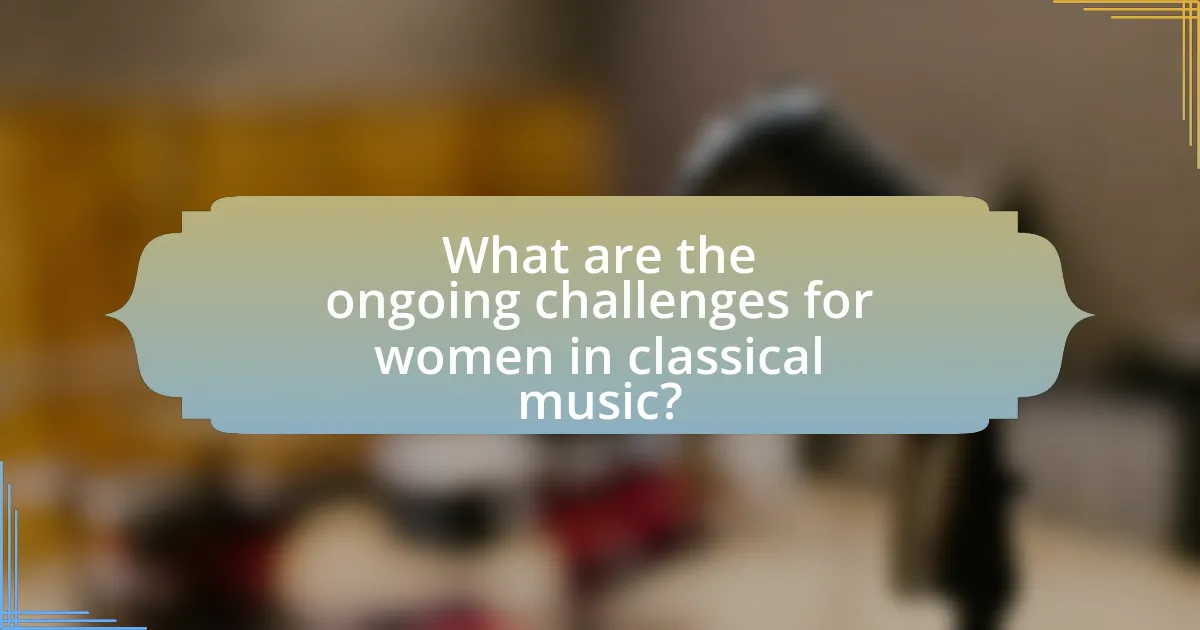
What are the ongoing challenges for women in classical music?
Ongoing challenges for women in classical music include gender bias, underrepresentation in leadership roles, and unequal pay. Despite progress, women hold only about 30% of orchestral positions and face barriers in gaining recognition for their contributions. Studies show that female composers and conductors are significantly less represented in programming and performances, with only 1-3% of works performed by major orchestras being composed by women. Additionally, women often encounter a lack of mentorship opportunities and face stereotypes that question their authority and expertise in the field.
How does gender bias manifest in classical music today?
Gender bias in classical music today manifests through unequal representation, pay disparities, and biased perceptions of women’s capabilities. For instance, women comprise only about 30% of orchestral musicians and even fewer hold principal positions, indicating a significant gender gap in visibility and leadership roles. Additionally, studies show that female composers receive less programming and performance opportunities compared to their male counterparts, with only 1.5% of works performed by major orchestras being composed by women. This disparity reflects a broader societal bias that undervalues women’s contributions in the field, perpetuating stereotypes about their artistic abilities.
What are the statistics on gender representation in orchestras and festivals?
As of recent studies, women represent approximately 30% of musicians in major orchestras and around 20% of conductors. A report by the League of American Orchestras in 2020 indicated that only 23% of the top 100 orchestras had a female music director. In festivals, the statistics are similarly low, with women comprising about 25% of featured composers and conductors at major classical music festivals. These figures highlight the ongoing gender disparity in the classical music field, despite some progress in recent years.
How do pay disparities affect female musicians in classical music?
Pay disparities significantly impact female musicians in classical music by limiting their financial stability and career advancement opportunities. Research indicates that female classical musicians earn approximately 20% less than their male counterparts, which can discourage women from pursuing long-term careers in the field. This wage gap not only affects their immediate income but also influences their ability to invest in professional development, such as training and networking. Furthermore, the lack of equitable pay can lead to decreased representation of women in orchestras and other prestigious ensembles, perpetuating a cycle of inequality within the industry.
What can be done to further support women in classical music?
To further support women in classical music, institutions should implement mentorship programs that connect emerging female musicians with established professionals. Research indicates that mentorship significantly enhances career advancement and retention rates for women in male-dominated fields, including music. For instance, a study by the National Endowment for the Arts found that women who received mentorship were more likely to secure performance opportunities and leadership roles. Additionally, increasing funding for female composers and conductors can help address the gender imbalance in programming and representation, as evidenced by the fact that only 1.5% of works performed by major orchestras in the U.S. are composed by women.
What strategies can organizations implement to promote gender equity?
Organizations can implement strategies such as establishing mentorship programs, conducting bias training, and promoting flexible work policies to promote gender equity. Mentorship programs can connect women with experienced professionals, enhancing career development and visibility in the classical music field. Bias training helps to raise awareness of unconscious biases that may affect hiring and promotion decisions, fostering a more inclusive environment. Additionally, flexible work policies can accommodate the diverse needs of employees, particularly those balancing family responsibilities, thereby supporting women’s participation and advancement in the industry. These strategies are supported by research indicating that organizations with mentorship and bias training programs see improved gender diversity and equity in leadership roles.
How can aspiring female musicians navigate the classical music landscape?
Aspiring female musicians can navigate the classical music landscape by actively seeking mentorship, participating in networking opportunities, and advocating for gender equality within the industry. Mentorship programs, such as those offered by organizations like the Women’s Philharmonic Advocacy, provide guidance and support from established professionals. Networking at events like conferences and masterclasses allows female musicians to connect with peers and industry leaders, fostering relationships that can lead to performance opportunities. Additionally, advocating for gender equality, as highlighted by studies showing that women are underrepresented in orchestras and leadership roles, empowers female musicians to challenge systemic barriers and promote inclusivity in classical music.
